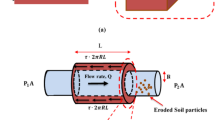Abstract
Characterizing soil erosion and predicting levee erosion rates for various levee soils and storm conditions during floodwall overtopping events is necessary in designing levee-floodwall systems. In this study, a series of laboratory scaled levee-floodwall erosion tests were conducted to determine erosion characteristics of fine grained soils subject to overtopping from different floodwall heights with variable flow-rates. A decreasing rate of erosion was observed as a pool of water was generated in the created scour hole at the crest of the levee model. The erosion rates were also assessed using jet erosion test (JET) and erosion function apparatus (EFA) tests. The results of levee-floodwall overtopping along with soil geotechnical characteristics such as plasticity index, compaction level, and saturation level of the levee soils as well as hydraulic parameters such as water overtopping velocity were used to develop a levee-floodwall erosion rate prediction model. Then, the results of JET and EFA were integrated to develop another prediction model for levee-floodwall erosion rate estimation. Consequently, the prediction models were evaluated by conducting additional tests and comparing the prediction results with the actual measured erosion rates.


Modified after Briaud et al. (2001)












Similar content being viewed by others
References
Allen P, Capello S, Coffman D (2010) Comparison of submerged jet testing to field erosion rates in clay and sand channels, blackland prairie ecosystem, Texas. In: 2nd Joint federal interagency conference, Las Vegas
Amini F, Li L, Xu Y (2013) Slope stability analysis of three earthen levee strengthening systems under hurricane overtopping flow conditions. In Geo-Congress. San Diego, CA, pp 1882–1891
ASTM-D5852 (2007) Standard test method for erodibility determination of soil in the field or in the laboratory by the jet index method. Annual Book of ASTM Standards, Philadelphia
Baars S (2004) Peat dike failure in the Netherlands. Official Publication of the European Water Association (EWA)
Briaud J, Ting F, Chen H, Cao Y, Han W, Kwak K (2001) Erosion function apparatus for scour rate predictions. J Geotech Geoenviron Eng 127:105–113
Briaud JL, Chen HC, Govindasamy AV, Storesund R (2008) Levee erosion by overtopping in New Orleans during the Katrina Hurricane. J Geotech Geoenviron Eng 134:618–632
Chang T, Chen S, Huang S (2011) Shelter effect evaluation of the willow works bank protection method: a case study for Beinn River Reach 2009 Typhoon Morakot event. Paddy Water Environ 11:15–33
Do XK, Kim M, Thao Nguyen HP, Jung K (2016) Analysis of landslide dam failure caused by overtopping. In 12th International conference on hydroinformatics. Procedia Engineering, pp 990–994
Hanson GJ, Cook KR (2004) Apparatus, test procedures, and analytical methods to measure soil erodibility in situ. Appl Eng Agric 20:455–462
Hanson G, Hunt S (2007) Lessons learned using laboratory JET method to measure soil erodibility of compacted soils. Appl Eng Agric 23:305–312
Hanson G, Robinson K, Cook K (2002) Scour bellow an everfall: part II. Prediction. Trans ASAE 45(4):957–964
Hughes SA, Nadal NC (2009) Laboratory study of combined wave overtopping and storm surge overflow of a levee. Coast Eng 56(3):244–259
Johnson EB, Testik FY, Ravichandran N, Schooler J (2013) Levee scour from overtopping storm waves and scour counter measures. Ocean Eng 57:72–82
Karimpour M, Heinzl K, Stendback E, Galle K, Zamiran S, Osouli A (2015) Scour characteristics of saturated levees due to floodwall overtopping. In: IFCEE, pp 1298–1307
Lasdon LS, Fox R, Ratner M (1973) Nonlinear optimization using the generalized reduced gradient method. Tech. Memp. 325, Department of Operatioanl Research, Case Western University, Cleveland, Ohio
Lasdon LS, Waren AD, Jain A, Ratner M (1978) Design and testing of a generalized reduced gradient code for nonlinear programming. J ACM Trans Math Softw 4(1):34–50
Li L, Amini F, Cuiping K, Briaud JL (2014) Erosion resistance of HPTRM strengthened levee from combined wave and surge. Geotech Geol Eng 32(4):847–857
Luthi M, Fannin RJ, Millar RG (2012) A modified hole erosion test (HET-P) device. Geotech Test J 35(4):1–5
Marot D, Regazzoni P, Wahl T (2011) Energy-based method for providing soil surface erodibility rankings. J Geotech Geoenviron Eng 137(12):1290–1293
Osouli A, Karimpour M, Safarian Bahri P (2017) Erosion characteristics of silty to clayey soils using EFA and lab-scaled levee-floodwall tests. Geotech Test J 40(3):396–410
Pan Y, Li L, Amini F (2015) Overtopping erosion and failure mechanism of earthen levee strengthened by vegetated HPTRM system. Ocean Eng 96:139–148
Shafii I, Briaud JL, Chen HC, Shidlovskaya A (2016) Relationship between soil erodibility and engineering properties. In: ICSE 2016. Harris, Whitehouse & Moxon (eds), Oxford
Tirpak SM (2009) United States army corps of engineers, Galveston district operational experiences and response to Hurricane Ike. Shore Beach 77(2):60–70
Villarini G, Smith J, Baeck M, Krajewski W (2011) Examining flood frequency distributions in the Midwest U.S. American Water Resources Association, p 447
Wahl TL (2010) A comparison of the hole erosion test and jet erosion test. In: Joint federal interagency conference on sedimentation and hydrologic modeling, Las Vegas
Wan CF, Fell R (2004) Investigation of rate of erosion of soils in embankment dams. J Geotech Geoenviron Eng 130(4):373–380
Xiao H, Huang W, Tao J (2009) Numerical modeling of wave overtopping a levee during Hurricane Katrina. Comput Fluids 38(5):991–996
Yu MH, Wei HY, Liang Y, Zhao Y (2013) Investigation of non-cohesive levee breach by overtopping flow. Hydrodyn Ser B 25(4):572–579
Yuan S, Li L, Amini F, Tang H (2015) Sensitivity of combined turbulent wave overtopping and storm surge overflow response to variations in levee geometry. J Coast Res 31(3):702–713
Acknowledgements
The authors acknowledge Mr. Brent M. Vaughn, laboratory specialist in Engineering department of Southern Illinois University Edwardsville, for assisting with the tests, and providing material and equipment to advance this study. The authors would like to thank Mr. David Molohon, Emaline Stendback, Sina Nassiri, Mazdak Karimpour, and Julian Chastain for their contribution in progress of this paper.
Author information
Authors and Affiliations
Corresponding author
Rights and permissions
About this article
Cite this article
Osouli, A., Bahri, P.S. Erosion Rate Prediction Model for Levee-Floodwall Overtopping Applications in Fine-Grained Soils. Geotech Geol Eng 36, 2823–2838 (2018). https://doi.org/10.1007/s10706-018-0505-z
Received:
Accepted:
Published:
Issue Date:
DOI: https://doi.org/10.1007/s10706-018-0505-z




